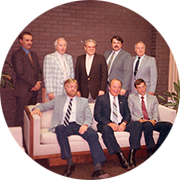From a small office on Broad Street on Jan. 13, 1967, 19 checks were mailed to retired police officers and firefighters who previously had received their benefits from the city where they had been employed.


This was the beginning of the Ohio Police & Fire Pension Fund. At that time, we were the Ohio Police and Fireman’s Pension and Disability Fund and faced a daunting task of creating a trusted, comprehensive retirement system from the remains of hundreds of small municipal funds around Ohio. In 2017, the Ohio Police & Fire Pension Fund celebrates 50 years of providing a more secure and reliable retirement income for our state’s public safety officers. In 1966, Amended House Bill 642 created the Ohio Police and Firemen’s Pension and Disability Fund, consolidating 425 individual funds.

When operations began on Jan. 1, 1967, assets totaling $75 million were transferred from these individual funds to OP&F. However, the new pension fund also inherited $490 million in liabilities. The progress made by OP&F since its creation is remarkable. Through periods of economic growth and recession the system has moved forward and established itself as a model for public safety retirement plans. It really is a testament to those who helped form and grow the system beginning 50 years ago, along with the many thousands of members who trust us to provide them with a secure pension.

The first headquarters of the retirement system were 88 E. Broad Street, in what is now the Key Bank building at the corner of Broad and Third Streets in downtown Columbus. The first chair of the Board of Trustees was Edward Schuele, who was the Director of Finance for the City of Cleveland Heights. Franklin Kropp was the first executive director (then called executive secretary). As to be expected, many things have changed since 1967. Member contributions to the pension fund were initially 6.0 percent of salary (now 12.25 percent). Employer contributions began at 13.55 percent for police employers and 13.13 percent for fire (now 19.5 percent for police and 24 percent for fire).

Although a state-wide fund did not begin operations until 1967, many individual municipal funds were in existence prior to 1900. In 1902, pension laws for all police and fire funds in Ohio were codified. At this time, an employer contribution tax of three-tenths of a mill on all real and personal property became mandatory to support each local fund. This did not change until the creation of OP&F. In 1939 it became mandatory for a municipality employing two or more firefighters to establish a pension fund. The same requirement for police departments became law in 1947. At this time, uniform benefits for both police and fire funds were established by Ohio’s General Assembly. Until then, each community set its own rules or formulas on benefits. Also in 1947, a modest state subsidy became available for local police and fire funds requiring financial assistance. Until the creation of OP&F, member contributions were optional and generally four percent of pay.

Today the OP&F investment portfolio is valued at more than $14 billion. It took until 1981 for the portfolio to hit the $1.0 billion level. Legislation passed by the Ohio General Assembly in 1981 increased the investment opportunities available to OP&F, making way for today’s successful investment program. According to the January 1982 OP&F member newsletter, “expands authority to invest in real estate, and increases the legal list of common stocks that may be purchased…” Since 1981, OP&F’s annualized return for investments is 9.58 percent. Today, policies are in place that aims to maximize returns and minimize both cost and risk over a wide variety of asset classes.

OP&F employs highly-qualified investment professionals who work with qualified consultants to advise the Board of Trustees on decisions and oversight of the portfolio. “The investment program is the backbone of OP&F’s financial success,” says Board of Trustee member David Heller, who is also Chair of the Board’s Investment Committee. Through the past 50 years the portfolio has seen remarkable growth, not in just dollars but also the diversity of asset classes and investment strategies.”

As our original name indicated, OP&F provides disability benefits in addition to service pensions. OP&F’s disability benefit process has been recognized as a fair, relevant and comprehensive program. The disability benefit process has evolved over the past 50 years. Prior to 1997, OP&F had come under some scrutiny regarding the process for granting awards. After careful review and study, the Disability Evaluation Panel was formed in January 1998. The panel consists of three OP&F trustees, three physicians and two vocational experts. The DEP reviews initial disability and reconsideration hearings. More recently, additional changes to the process have resulted in assuring that disability benefits are awarded to those who are most deserving.

In 2013, the Board of Trustees approved significant program changes, with guidance from their medical and vocational advisors, by removing the consideration of non-disabling conditions from the benefit calculation. The change was designed to give weight only to conditions that are considered disabling and permanent impairments. In 2012, the number of initial disability hearings numbered 215 with 182 awards being granted. By 2014 the total dropped to 128 with 107 awards granted. While the move away from non-disabling conditions can be credited, a change in conditioning and better training and tools from employers are also factors. As a result, OP&F has experienced positive actuarial gains for the past eight years totaling in excess of $1 billion relative to our assumptions.

Perhaps the most significant benefit change in OP&F’s first 50 years came in 2003 when legislation allowed the formation of the Deferred Retirement Option Plan (DROP). This optional benefit allows members who are eligible to retire to stay on duty serving their communities for up to eight years once they enter DROP. Once they retire, a lump sum of money is available in addition to the pension the member has earned. Today, more than 90 percent of those who are eligible participate in DROP.

In 2008 a severe financial crisis negatively affected OP&F’s long-term funding. While OP&F had been advocating for changes to its funding formula for many years, the economic downturn brought the problem to the forefront. The result was pension reform legislation that was passed in 2012. Ohio Senate Bill 340 increased member contributions, changed cost of living adjustments and pension calculations. The effects of Senate Bill 340 were critical to OP&F’s long term funding after the financial crisis. Our entire membership sacrificed changes in benefit structure as the law’s provisions required no additional tax payer dollars.

OP&F has offered retired members access to a health care plan since 1974. Back then the costs were mostly negligible for both the pension fund and participants, so while OP&F was not required to offer a plan to its members, it was affordable and popular. However, costs increased, steadily at first and more dramatically in recent years. Finally, this self-insured group plan became unsustainable. In December 2017, the Board of Trustees voted to change to a stipend-based model where eligible retirees would receive a fixed amount from OP&F to purchase a health care plan that best fits their needs and budgets. The transition to the stipend-based model took place on Jan. 1, 2019.

As the COVID pandemic changed the world, what did not change was OP&F’s mission. Despite OP&F headquarters being closed to the public for most of 2020 and the beginning of 2021, all benefits continued to be paid on time and as expected. Essential business operations continued uninterrupted with most staff working remotely. Phone and online retirement meetings became the norm instead of meeting in person, providing new opportunities for members going forward. OP&F emerged with increased capabilities and awareness on how to meet challenges, no matter how unprecedented.
